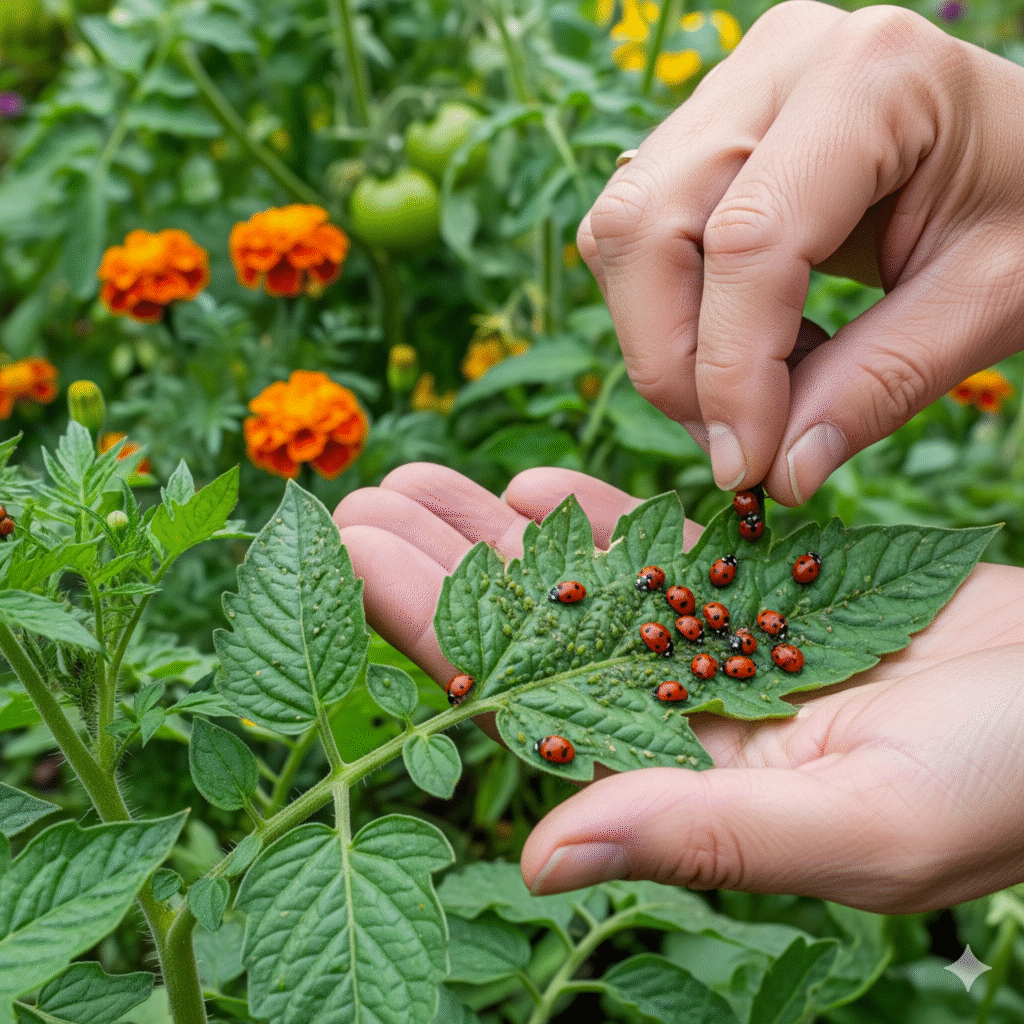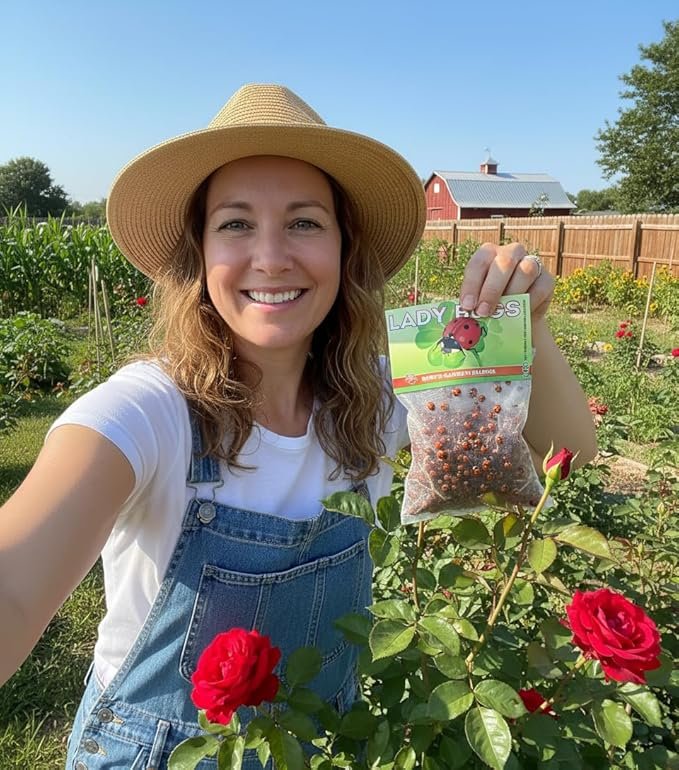Do you ever gaze at your vibrant garden, brimming with life, only to spot an unwelcome visitor munching on a prized leaf or drilling into a perfect fruit? The sight of garden pests can send a shiver down any gardener’s spine. The immediate impulse might be to grab a quick-fix spray, but for those committed to a sustainable lifestyle, that’s not the “unplugged routine” way.
At UnpluggedRoutine.com, we believe in working with nature, not against it. That’s why mastering organic pest control tips for eco gardeners isn’t just a strategy; it’s a philosophy. It’s about building a resilient ecosystem where your plants thrive naturally, and pests are kept in check by nature’s own ingenious systems.
Forget the chemical warfare that harms beneficial insects, contaminates your soil, and risks your harvest. This comprehensive guide will equip you with 7 powerful, eco-friendly strategies to protect your plants, foster biodiversity, and ensure your garden remains a healthy, productive haven. Get ready to cultivate a garden where nature does the heavy lifting, leaving you to simply enjoy the bounty!

Table of Contents
The Organic Advantage: Why Ditch the Chemicals?
Before we dive into the “how,” let’s reinforce the “why.” Traditional pesticides often operate with a broad brush, killing indiscriminately. This means they wipe out not only the “bad” bugs but also the “good” ones – the ladybugs, lacewings, and parasitic wasps that are your garden’s best allies. This creates an imbalance, often leading to even worse pest problems down the line.
Beyond that, synthetic pesticides can:
- Contaminate Soil & Water: Residues can persist in the soil and leach into groundwater, polluting local ecosystems.
- Harm Beneficial Organisms: Beyond insects, pesticides can harm birds, amphibians, and other wildlife.
- Pose Health Risks: Residues can remain on harvested produce, posing risks to human and pet health.
By embracing organic pest control tips for eco gardeners, you’re creating a safer, healthier environment for your family, your plants, and the planet. You’re building a truly sustainable garden from the ground up.
Your Pest-Proof Blueprint: What You’ll Discover
This post will guide you through:
- Understanding the holistic approach to pest management.
- 7 powerful, natural strategies to prevent and control garden pests.
- How to build a garden that inherently resists common invaders.
- Transforming your garden into a balanced, thriving ecosystem.
Let’s empower your plants to defend themselves and protect your precious harvest!
1. Build a Foundation of Healthy Soil: Strong Plants Resist Pests
This might seem indirect, but it’s the most fundamental organic pest control tip for eco gardeners: a healthy plant growing in healthy soil is inherently more resistant to pests and diseases. Think of it like a human with a strong immune system – less likely to get sick.
Compost is King (and Queen):
- Nutrient-Rich: Compost slowly releases a balanced array of nutrients, leading to robust plant growth and strong cell walls, making plants physically tougher for pests to penetrate.
- Microbial Diversity: Healthy soil, teeming with beneficial bacteria and fungi (thanks to compost), can actually help suppress disease-causing pathogens and even deter root-feeding pests.
- Water Retention: Compost improves soil structure, helping it retain water more efficiently, reducing plant stress which can make plants more vulnerable to pests.
Focus on feeding your soil with organic matter like compost, worm castings, and mulches. This creates a living, breathing ecosystem below ground that directly impacts the health and resilience of your plants above ground.
2. Embrace Biodiversity & Companion Planting: Nature’s Bodyguards
A diverse garden is a resilient garden. Monocultures (large plantings of a single crop) are like an open invitation for specific pests. Organic pest control tips for eco gardeners emphasize variety.
The Power of Interplanting:
- Confuse Pests: Many pests locate their host plants by scent or sight. Interplanting a variety of different plants can confuse them, making it harder for them to find their target.
- Attract Beneficials: Certain plants act as “beacon plants” for beneficial insects.
- Repel Pests: Some plants naturally emit compounds that repel specific pests.
Strategic Companion Planting Examples:
- Marigolds (Tagetes spp.): Known to deter nematodes (microscopic worms that attack roots) and other pests. Plant them throughout your vegetable beds.
- Nasturtiums: Often called “trap crops.” Aphids love them more than your prize veggies, so they’ll gather on the nasturtiums, leaving your other plants alone. You can then easily remove the infested nasturtiums.
- Herbs (Basil, Dill, Mint, Rosemary, Thyme): Many aromatic herbs are fantastic for deterring pests. Basil planted near tomatoes can help repel tomato hornworms, while rosemary can deter bean beetles and carrot rust flies.
- Alliums (Onions, Garlic, Chives): Their strong scent can confuse and repel a wide range of pests, including aphids and slugs.
By carefully planning your garden’s layout, you can create a natural defense network that makes it much harder for pests to get a foothold.
3. Attract Beneficial Insects: Your Garden’s Tiny Army
This is one of the most exciting and effective organic pest control tips for eco gardeners. Instead of spraying, you invite the good guys to do the dirty work for you!
Who Are These Heroes?
- Ladybugs (Lady Beetles): Famous for devouring aphids, but also eat scale insects, mealybugs, and mites.
- Lacewings: Their larvae are voracious predators of aphids, thrips, mealybugs, and whiteflies.
- Hoverflies (Syrphid Flies): The larvae of these bee-mimics are formidable aphid eaters.
- Parasitic Wasps: Tiny wasps that lay their eggs inside or on other insects (like aphids, caterpillars, whiteflies), effectively controlling pest populations.
- Praying Mantises: Large, generalist predators that will eat almost any insect they can catch.
How to Roll Out the Welcome Mat:
- Plant Nectar & Pollen Sources: Beneficial insects need food too! Plant a diverse array of small-flowered plants, especially those with flat flower heads, which provide easy access to nectar and pollen.
- Examples: Dill, cilantro, fennel, parsley, yarrow, cosmos, zinnias, sweet alyssum, calendula.
- Provide Water: A shallow bird bath with stones for perching or a small, damp area can attract beneficials.
- Create Shelter: Leave a small patch of “wild” area, a rock pile, or a small brush pile for shelter.
- Avoid Pesticides: Even organic pesticides can harm beneficials, so use them only as a last resort and with extreme caution.
Want to bring in the troops right away? You can give your garden’s ecosystem a major boost by ordering beneficial insects online. Releasing a batch of Live Ladybugs from a trusted seller like Nature’s Good Guys is a fun and incredibly effective way to let nature’s pest patrol take care of an aphid problem for you.

4. Employ Physical Barriers & Traps: Hands-On Protection
Sometimes, the simplest solutions are the best. Physical barriers and traps offer direct protection without chemicals.
Row Covers:
- What they are: Lightweight fabric covers that are draped over plants and secured to the ground.
- Benefits: Create a physical barrier that prevents flying insects (like cabbage moths, squash vine borers, flea beetles) from laying eggs on your plants. Allows light and water through.
- When to Use: Ideal for protecting young seedlings and vulnerable crops. Remember to remove them during flowering for crops that need pollination.
Collars & Barriers:
- Cutworm Collars: Place a cardboard or plastic collar around the base of young seedlings to prevent cutworms from severing them at soil level.
- Copper Tape/Diatomaceous Earth: For slugs and snails, copper tape around raised beds or a sprinkle of diatomaceous earth (a natural, abrasive powder) can create barriers they don’t like to cross.
Traps:
- Sticky Traps: Yellow sticky traps can catch flying pests like whiteflies, thrips, and fungus gnats, helping to monitor and reduce populations.
- Pheromone Traps: Release specific insect pheromones to attract and trap male pests, disrupting their breeding cycle.
- Beer Traps (for slugs/snails): A shallow dish of beer sunk to soil level can attract and drown slugs and snails.
5. Practice Good Garden Hygiene & Crop Rotation: Prevention is Key
Many pest problems can be prevented with good garden habits. These are foundational organic pest control tips for eco gardeners.
Garden Cleanliness:
- Remove Plant Debris: Don’t leave fallen leaves or spent plants lying around, as they can harbor pests and diseases. Compost healthy debris.
- Weed Control: Weeds compete for nutrients and can also host pests or diseases. Keep your garden beds relatively weed-free.
- Sanitize Tools: Clean your pruning shears and other tools between uses, especially if you’ve been working with diseased plants, to prevent spreading issues.
Crop Rotation:
- What it is: The practice of planting different crops in different areas of your garden each season.
- Why it works: Many pests and diseases are crop-specific and can build up in the soil if the same plant is grown in the same spot year after year. Rotating crops breaks these cycles. For example, if you had tomato hornworms one year, planting a different family of vegetable (like beans) in that spot next year can starve them out.
6. Hand-Picking & Pruning: Direct Intervention
Sometimes, the most direct approach is the simplest and most satisfying. This is a very hands-on organic pest control tip for eco gardeners.
Hand-Picking:
- When to do it: For larger, visible pests like tomato hornworms, squash bugs, slugs, or Colorado potato beetles.
- How to do it: Simply pluck them off your plants (gloves are recommended for some!), drop them into a bucket of soapy water, or move them far away from your garden. Do this regularly, especially in the morning or evening.
Pruning Away Infestations:
- Targeted Removal: If you see a small section of a plant heavily infested with aphids or mealybugs, sometimes the quickest solution is to prune off that entire section and dispose of it (e.g., put it in the trash, not compost if it’s a severe infestation). This prevents the problem from spreading.
- Improve Airflow: Pruning can also improve air circulation around plants, which helps prevent fungal diseases that often make plants more vulnerable to pests.
7. Use Organic Sprays & Controls (As a Last Resort): Targeted Treatment
Even in the most well-managed organic garden, sometimes a pest problem can get out of hand. In these situations, organic pest control tips for eco gardeners include using targeted, natural sprays as a last resort.
Always Choose Wisely:
- Targeted, Not Broad-Spectrum: Look for products that specifically target your pest, not everything.
- Low Impact: Choose options that break down quickly and have minimal impact on beneficial insects.
- Read Labels: Always follow directions carefully.
Common Organic Sprays:
- Insecticidal Soap: Effective against soft-bodied insects like aphids, whiteflies, mealybugs, and spider mites. It works by disrupting their cell membranes. Requires direct contact.
- Neem Oil: A natural extract from the neem tree. It acts as an antifeedant, growth disruptor, and repellent for many pests. It’s also effective against some fungal diseases. Less harmful to beneficials once dry.
- Bacillus thuringiensis (Bt): A naturally occurring bacterium that is highly effective against specific caterpillar pests (like cabbage loopers and tomato hornworms) but harmless to other insects, pets, and humans. There are different strains for different pests.
Remember, even organic sprays should be used judiciously. The goal is to return your garden to a natural balance, not to eliminate every single bug.

Embrace Nature’s Wisdom!
Mastering organic pest control tips for eco gardeners is an empowering journey that transforms your garden into a resilient, self-regulating ecosystem. It’s about shifting your mindset from battling nature to partnering with it, allowing beneficial insects, healthy soil, and strategic planting to do the heavy lifting.
This approach not only protects your plants and yields a healthier harvest but also enriches your connection to the natural world – the very heart of the Unplugged Routine. Every choice you make, from adding compost to planting a pollinator-friendly flower, strengthens your garden’s natural defenses.
Which of these organic pest control tips are you most excited to implement in your garden? Share your favorite natural methods or pest success stories in the comments below! Let’s grow a vibrant, pest-resilient community together!